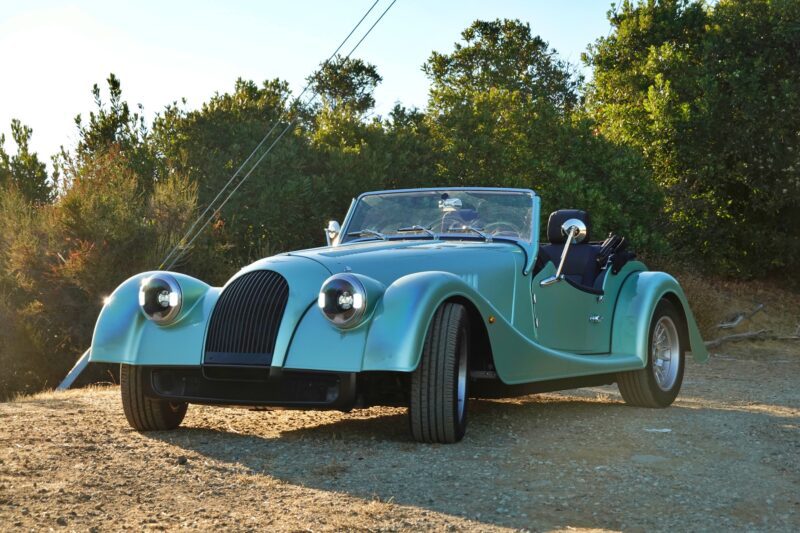The last time British coachbuilder Morgan sold the historic Plus Four model here in the United States, in 2005, the chassis was literally made of plywood – or so the urban legend goes. In point of fact, Morgan always used a steel chassis from the Plus Four’s debut in 1950 all the way until the latest generation debuted in 2020.
But that rumor likely grew out of the fact that the Plus Four still uses ash wood for the body frame, even now in 2025, as Morgan begins to ship the latest generation to the United States complete with a BMW powertrain, Bluetooth connectivity, and a stretched design that fits more people more comfortably – all riding on a new aluminum chassis structure beneath the skin. Super.
Unfortunately, in a baffling decision, Morgan decided against importing a manual transmission-equipped Plus Four to the United States. A stick shift is available in Europe, but this meant that I recently borrowed a press loaner, not just eager to learn about the new aluminum chassis, but also to experience how such purposefully vintage style matches – or clashes – with the inability to row my own gears.
The Plus Four Returns To America

Morgan sources the engine and transmission as a unit from BMW, in this case, a turbocharged 2.0-liter inline-four good for 255 horsepower and 295 pound-feet of torque, married to an eight-speed torque converter automatic. Calling the little mill a commuter car engine makes some semblance of sense, given the relatively low 6,500-rpm redline. But remember, this tiny roadster weighs just 2,293 pounds, thanks to the aluminum chassis and ash wood body frame.
With plenty of low-end torque on tap to scoot that minimal mass around, Morgan claims the Plus Four can manage a 4.8-second sprint to 100 kmh (62 mph) when equipped with the automatic. But don’t worry about feeling cramped into such a tiny car, which, despite actually measuring slightly less in overall length than the preceding generation, uses an 82 mm longer wheelbase. Technically, the Plus Four counts as a replica car, but it’s also 40 mm wider and 31 mm taller than before, so I fit just fine at six-foot-one despite the two seats being close enough together for the occasional elbow bump with a passenger.
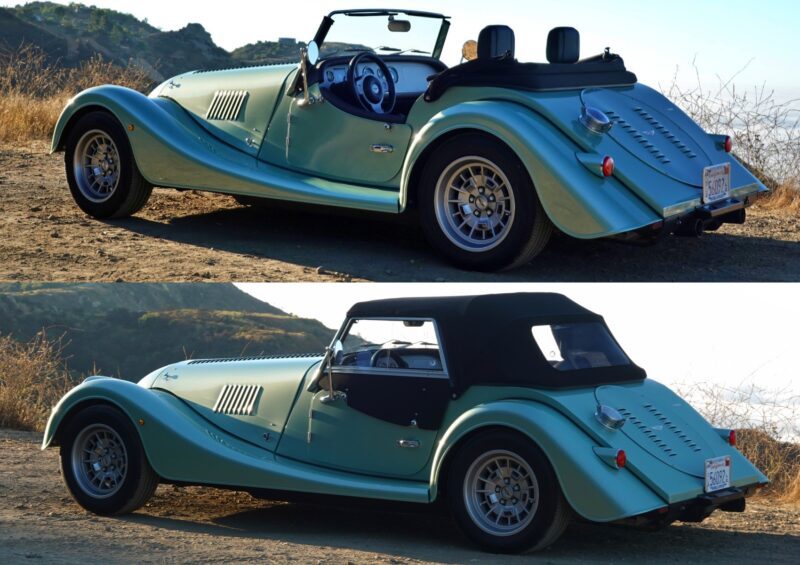
Just don’t ask about climbing in and out, which simply cannot be done without a bit of awkwardness. There’s no real armrest on the doors, either, and the pedal box barely fit my size 10 shoes – imagining a clutch pedal squeezed in, I began to appreciate the automatic transmission a little more. The steering wheel adjusts up and down, without telescoping in and out, but I found the seats ride low enough to create plenty of headroom with the convertible top in place. Matching the exterior, the optional Comfort Plus seats hew more toward a classic cruiser mentality rather than a hardcore sports car.

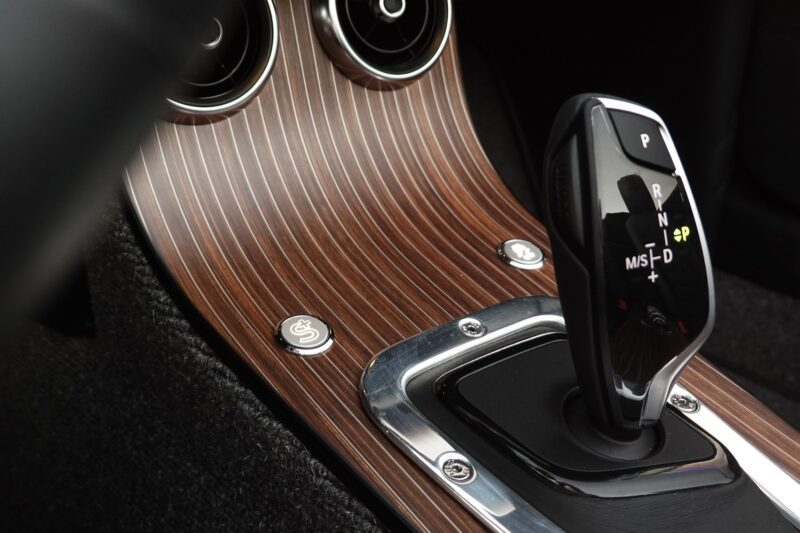
And yet, the lightweight chassis makes driving the Plus Four anywhere near the limit a ton of fun. Modern supercars with the power-to-weight ratios of racecars (or better) are one thing, but a lightweight and low-slung sports car with just the right amount of power can nonetheless feel exponentially faster. Not just because sitting so close to the ground creates a forced perspective, but because cornering and braking require so much less grip to hold and haul down legitimate pace. All while the BMW inline-four churns out a mirthful soundtrack, turbo spooling up and exhaust overrun burble from the exhaust pipes that seemed to stick out immediately behind my skull.
The auto transmission even works fairly well, even if it’s not as snappy as a dual-clutch and prefers stately driving more than hard charging. But skipping the manual here in the United States absolutely misses the mark. Sure, take rates for stick shifts in the U.S. pale in comparison to Europe – but this car’s target customer base is a self-selecting sample that clearly wants something out of the ordinary, rather than a commuter EV or a more modern sports car.
Modernized, Yet Timelessly Classic
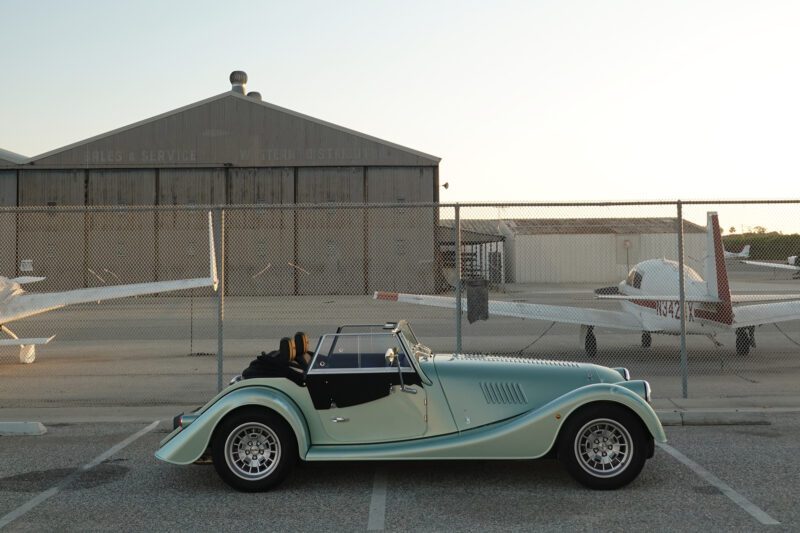
The first time I pulled away in the Plus Four, I marveled at how battened down the chassis feels. Cracks in the road and speed bumps created no suspension clunks or wobbles, quite an impressive feat for a car so small that it’s built using wood. Plus, with so little weight over the rear, the Plus Four happily chirped the tires loose between shifts up to third gear once I popped the horrific BMW shifter to the left for Sport mode.
That futuristic, angular design looks entirely out of place here – even more so than in an Ineos Grenadier. Selecting Sport+ then requires pushing a much more pleasing metal button ahead and to the left on the walnut center console, and I regularly held down the mirrored ESC button to fully turn off traction control intervention. This brought up a small warning on the mildly configurable digital gauge screen, another concession to modernity that seems slightly out of place in something otherwise analog.

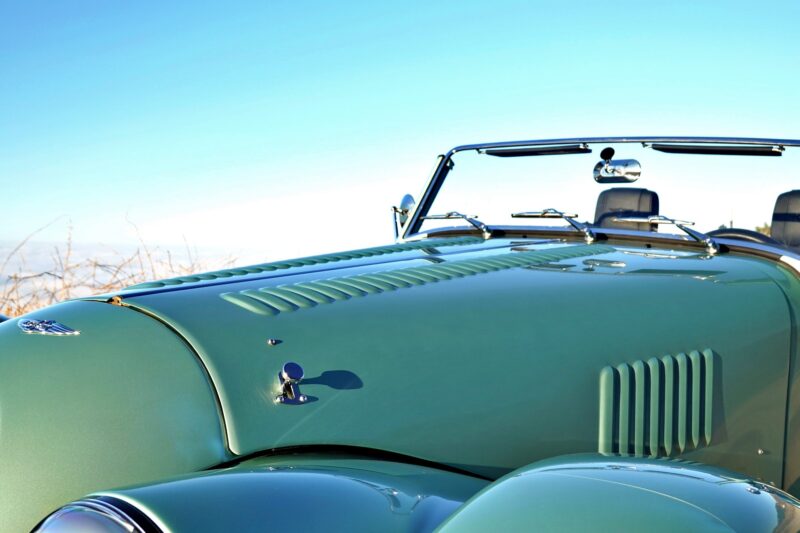
This particular Morgan arrived in America equipped with the Dynamic Handling Pack, a $2,410 option that adds adjustable shock dampers, a rear sway bar, and marginally stiffer rear springs. In its factory setting, the suspension tuning perfectly bridges the gap between firm and compliant – simultaneously comfortable enough for daily life but also stiff enough to handle hard cornering in canyons. With a bit more mass from the engine out front, the rear sway bar in particular contributes to a happy propensity toward easily controlled slides, which give way to oversteer in a satisfying and communicative transition while whipping through consecutive curves.
The Plus Four serves as yet another reminder that having slightly more power than tire traction makes driving a ton of fun. Sure, modern sports cars and supercars can go right ahead and chase lap times with those enormous tires on enormous wheels, Morgan seems to say. Instead, the Plus Four sticks with a scant set of 205-millimeter Avons mounted on 15-inchers that reminded me of Campagnolo wheels on Maseratis from the late-1970s and early-80s.
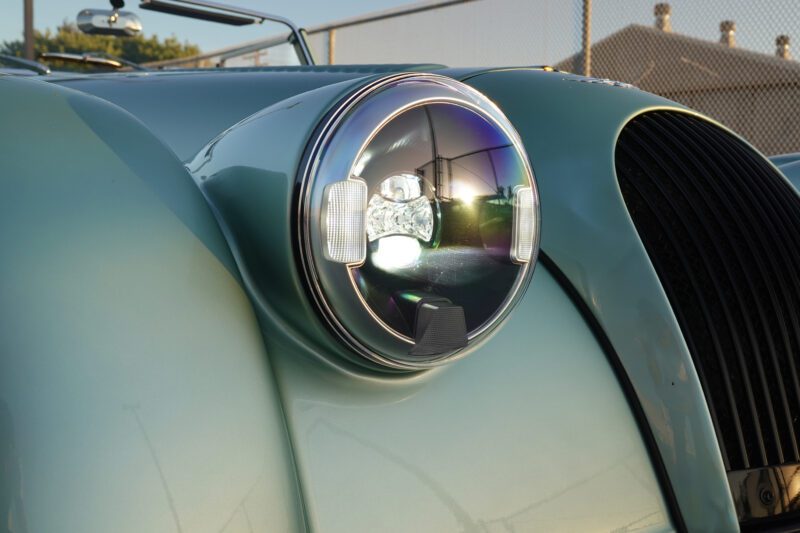
As surprisingly well as it drives, the Plus Four nails the classic style even better. Ice Green metallic paint absolutely glistens, highlighting every swooping curve from every angle. I’d still take a little spare tire on the rear decklid, though, and the profile definitely looks best with the top laid back and the side panels removed – from both a design standpoint and the driver’s perspective. I removed the side panels almost immediately, using a little tool on the key ring to loosen metal knobs on the exterior of the doors. A carrying case then protects the glass and leather from damage, though the whole package doesn’t quite fit behind the seats nicely.
Morgan clearly invested a ton of time and effort into developing the new bonded aluminum chassis, as confirmed by the impressive ride quality. But a close eye on build quality is also clearly reveals some smaller details that went overlooked, in addition to where to store the door panels: one glued-on leather panel already detaching from a door, a hilarious lumbar support system actuated by flimsy hand pumps zip-tied in front of the lower seat cushion, nice metal dials for the climate control and volume that were unfortunately designed in such a way that the decals becomes meaningless once spun around in any direction.
Worst of all, the sun visors mount to the top of the windshield surround with a long Allen bolt and spacer, but no rubber washers or dampers of any kind. So, any smallest reverberation from the road or wind caused horrific rattling directly in front of my face on every single drive. On my own car, I would remove and replace this tiny yet unignorable annoyance, but that’s not exactly the kind of thing I want to be doing with my brand-new six-figure toy.
Morgan Plus Four: Conclusions

I gave back the Morgan, sad to see it go. Over the course of the loan, I increasingly grew comfortable daily driving around big pickup trucks and SUVs with tires that rode about as high as my shoulders. There’s simply nothing else new quite like the Plus Four on American roads, as lightweight sports cars increasingly go extinct. And the style truly elevates the Morgan into a class of one: this little British roadster turned more heads than any car I’ve ever driven bar none, including Ferraris, Lamborghinis, Bugattis, and more!
Imagining a Plus Four in the driveway next to a G-Wagen (or a Grenadier, for that matter) sure seems like a perfect two-car solution for daily life and weekend fun. Such a unique, bespoke character makes the base price of $84,995 seem fairly reasonable, though my tester ramped up to $103,970 as optioned. Most importantly, all the attention the Plus Four received from pedestrians and other drivers brought a smile to everybody’s face, not just mine, as I ripped around town, despite lamenting the lack of a manual transmission, which would simply take the cake.
Images: Michael Van Runkle
